What is ‘Tonnage’ When Applied to Ships?
‘Old measure’, ‘new measure’, ‘gross’, ‘net’ – you could be forgiven for thinking that tonnage gets quite complicated when it comes to ships! Here, MAT volunteer, Roger Burns, explains these terms and throws in a range of sites that we have investigated to help demonstrate.
The term tonnage is not a reference to the weight of a merchant ship. It is an indication of a ship’s size or cargo-carrying capacity and is used for assessing the duty or fee applicable for crew regulations, registration, port charges, and the like. How tonnage has been defined and calculated for ships has changed several times. Let’s find out more.
TONNAGE WHEN APPLIED TO MERCHANT SHIPS
In 1303, King Edward I was the first to levy a tax on ships, based on tons burthen. Subsequently, King Edward III levied a tax on imported wine, on each ‘tun’, which then was a wine container of 252 gallons (1.146m3) weighing about 2,240 lb (1,020 kg), a weight known today as a long ton or imperial ton. The estimated capacity of a ship in ‘tuns’ for tax purposes was expressed with dimensions in feet (Length x Beam x Depth)/100, depth being the hold depth below the main deck – the numerator gives the ship’s volume in ft3, and the denominator was a ‘tun’ deemed to be equivalent to 100ft3.
The beam of a ship as used in tonnage assessments is its overall width at its widest point of permanently fixed parts, and the length of a ship is defined in different ways for different applications, which for tonnage is the length overall.
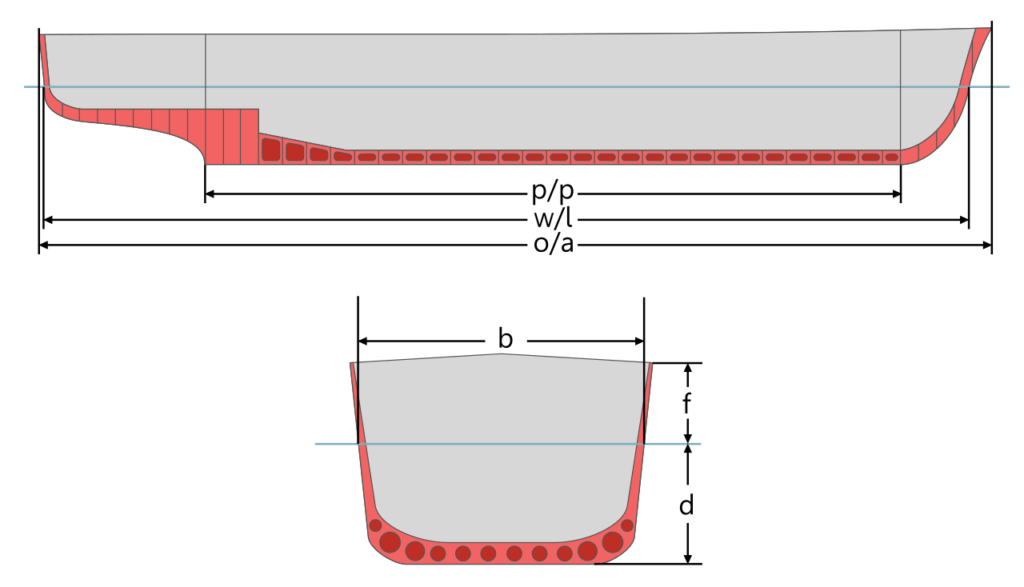
p/p = length between perpendiculars
w/l = length at waterline
o/a = length overall
b = beam, in the schematic taken at the waterline but for tonnage assessments taken at its widest point
f = freeboard
d = draught
Source: https://en.wikipedia.org/wiki/Beam_(nautical)
CC BY-SA3.0
From about 1650 until 1849, Builder’s Old Measurement, burden or burthen, abbreviated to either BOM, bm, OM or o.m., was used to calculate the cargo capacity of a ship and remained in use until steam propulsion began to be adopted. Again, dimensions were in feet, length being stem to sternpost, tonnage being calculated as [{Length – (Beam x 3/5)} x Beam x Beam/2]/94.
In 1678, Thames shipbuilders introduced their own variation on the assumption that a ship’s burden was 3/5 of its displacement. As tonnage was assessed by Length x Beam x Draught x Block Coefficient divided by 35ft3 per ton of seawater, their formula for tonnage was {L x B x B/2 x 3/5 x 0.62}/35. The term block coefficient, of a ship, can be expressed as the ratio of the underwater volume of the ship’s hull to the volume of a rectangular block of the same length, width and height. (Formulae can be accessed at Steamship Mutual, Gard and Wikipedia).
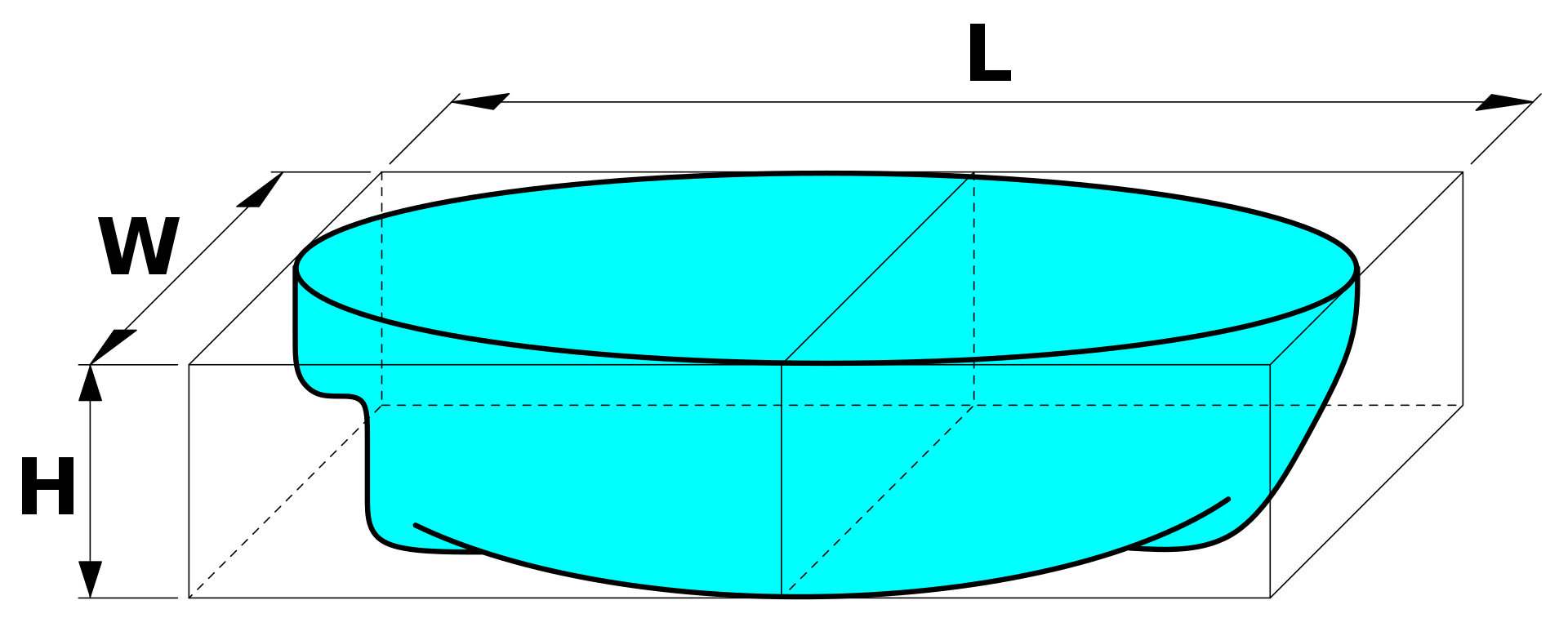
An example of a ship whose tonnage would have been expressed using the pre-1849 method of calculation is the SV Clarendon, built in Chepstow in 1823. This wooden-hulled, copper-sheathed ship was 345 tons burthen. Clarendon ran aground off Blackgang Chine on 11 October 1836 on route to St Kitts from London. It was carrying passengers, rum, sugar, molasses, coconuts, peppers and cedar. There were three survivors of the 25 onboard. A picture of the Clarendon can be seen at the Isle of Wight Shipwreck Centre and Maritime Museum.
THE GEORGE MOORSOM METHOD
Different nations used different rules to measure ships’ tonnage. In 1854, George Moorsom devised another ship measurement system whereby a better indication of a ship’s size should be based on the ship’s volume in ft3 and reflect the earning ability of the ship to arrive at appropriate service fees levied by ports. This method was enshrined in Britain’s first British Shipping Act (1854), and because the unit of such measurement had always been ‘tons’, the expressions gross and net registered tonnage were adopted, abbreviated to ‘grt’ and ‘nrt’ respectively.
The gross-registered tonnage was the enclosed under deck volume of the ship (ft3) and the net-registered tonnage was derived by deducting non-cargo carrying volumes from the gross figure, thus reflecting earning capacity. The permitted deductions included Master and crew accommodation, safety and storage spaces, water ballast tanks, and an allowance for propelling machinery. As the resultant figures were large, both were divided by 100 to arrive at more manageable values, thus one registered ton was the equivalent of 100 ft3 (2.83m3), and the values were used for ships’ Certificates of Registry. George Moorsom was appointed Surveyor General for Tonnage under the above Act. The Act also introduced the allocation of Official Numbers for registered ships (not Naval ships), which are scheduled within the Mercantile Navy List.
The information held by Lloyd’s for British merchant registered ships, including tonnages, followed requirements expressed by the appropriate Acts for the relevant periods.
An example of the Moorsom method (by which the relevant values are given to arrive at the gross and net registered tonnages) is set out in Lloyd’s ‘Iron Ship report for Smyrna, 14th November 1876’, as follows:
| Tonnage under Tonnage Deck | 1185.22 |
| Ditto of Poop | 107.92 |
| Ditto of Houses on Deck | 22.37 |
| Ditto of Forecastle | 56.63 |
| Gross Tonnage | 1372.14 |
| Less Crew Space | 67.54 |
|
Register Tonnage as cut on Beam |
1304.60 |
Launched at Aberdeen on 18 October 1876, Smyrna was classified as a two-decked ship in the Lloyd’s report, which provides copious details of construction with applicable dimensions, but not the actual calculations used to arrive at the tabulated values. Interestingly, the report also states that the ship’s destined voyage is to Sydney. Smyrna was in service until 1888 as a 3-masted passenger/cargo sailing vessel, when it was sunk south of the Isle of Wight following a collision in fog, the account of which is related here.
STANDARDISING TONNAGE CALCULATIONS
Another variation, which was introduced by the Royal Thames Yacht Club in 1855, as a variation on the Builder’s Old Measurement was called Thames Tonnage and intended for yachts and similar vessels. It was also used for yacht racing handicaps and is expressed by {(length-beam) x beam2}/94.
The Moorsom method was followed from the early 1900s by most maritime nations, but because of different interpretations by different countries, including the precise terminal points of physical measurement, coupled with some national modifications, the resultant figures were not always directly comparable.
In 1925, international efforts were made to standardise the calculation of tonnages but it was 1969 before this was achieved, pursuant to the IMO International Convention on Tonnage Measurement of Ships (1969). This initially entered into force on 18th July 1982 for new ships and fully entered into force on 18th July 1994 for all ships except warships, ships of less than 24 metres in length, and some lake and river vessels. IMO terminology adopted Gross Tonnage (GT) and Net Tonnage (NT), replacing grt and nrt. Panama and Suez canals retain their own method of measurement for fee charging purposes.
TONNAGE WHEN APPLIED TO NAVAL SHIPS
Naval ships typically use, and have always used, Displacement for tonnage descriptions, although pre-19th century vessels also quote burthen. A ship’s ‘displacement’ is the volume of water it displaces when it is floating. This is measured in cubic metres (m3). Its ‘displacement tonnage’ is the weight of the water that it displaces when it is floating with its fuel tanks full and all stores on board. This is measured in metric tons (MT, equivalent to 1,000 Kg). The displacement tonnage is the actual weight of the ship, since a floating object displaces its own weight in water, as given by Archimedes’ principle.
An example of a warship that had its tonnage quoted with both displacement and burthen is HMS Eurydice, an Admiralty wooden-hulled, copper-sheathed, three-masted (full-rigged), 26-gun frigate. The ship was lost on 24 March 1878 in Sandown Bay, Isle of Wight with over 300 casualties when, returning from Bermuda, it encountered a heavy squall and snow storm. The ship had a gundeck 43.03m long, a beam of 11.84m, and tonnage quoted as 908 burthen and as 921 tons displacement. The Eurydice was raised but had deteriorated beyond repair while submerged and was broken up. A commemorative book of the disaster, made out of wood recovered from the wreck, is on display at the Shipwreck Centre & Maritime Museum.
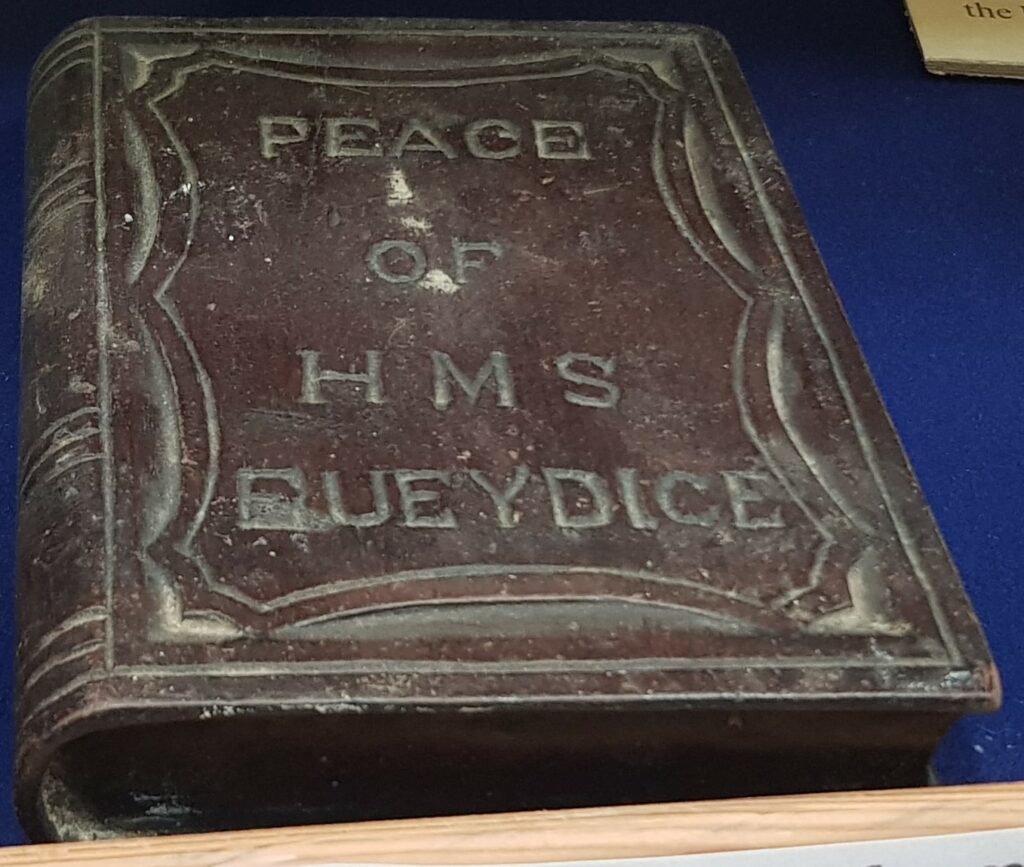
The Mercantile Navy List typically records grt and nrt, although small wooden vessels often have a single tonnage. The List does not include vessels owned by the Admiralty but it does include Admiralty-requisitioned or Admiralty-hired ships and records of other British ships from 1855 to the 1970s. Apart from tonnage, extensive registered information is provided.
The Admiralty-owned ships included within the Forgotten Wrecks of the First World War project dataset offer some great examples of tonnage being applied to ships. They typically use Displacement tonnage, an example being HMS Boxer, a “27 knotter” torpedo boat destroyer with displacement tonnage of 249 tons light and 306 tons fully-loaded. It was 61.47m long with a 5.7m beam, steel-hulled, and driven by two four-cylinder triple expansion steam engines with three coal-fired water tube boilers. It was lost in a collision on 8 February 1918 in Sandown Bay.
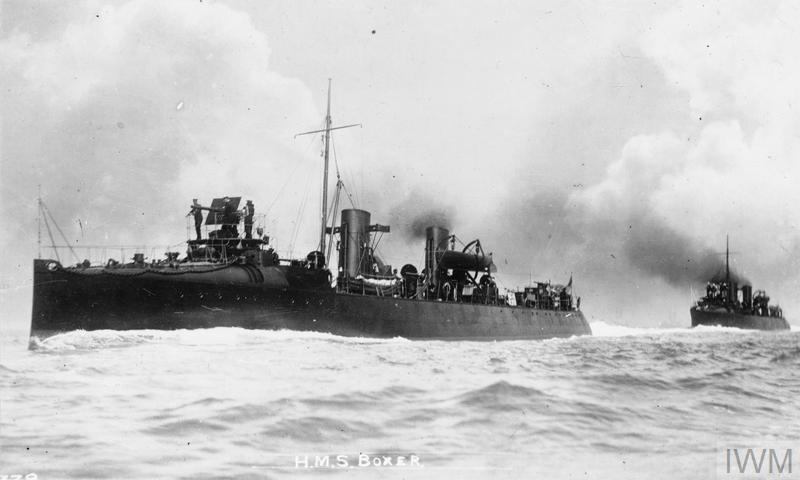
HMS Boxer
Source: https://www.iwm.org.uk/collections/item/object/205319769
IWM Non-Commercial Licence. © IWM Q 74982
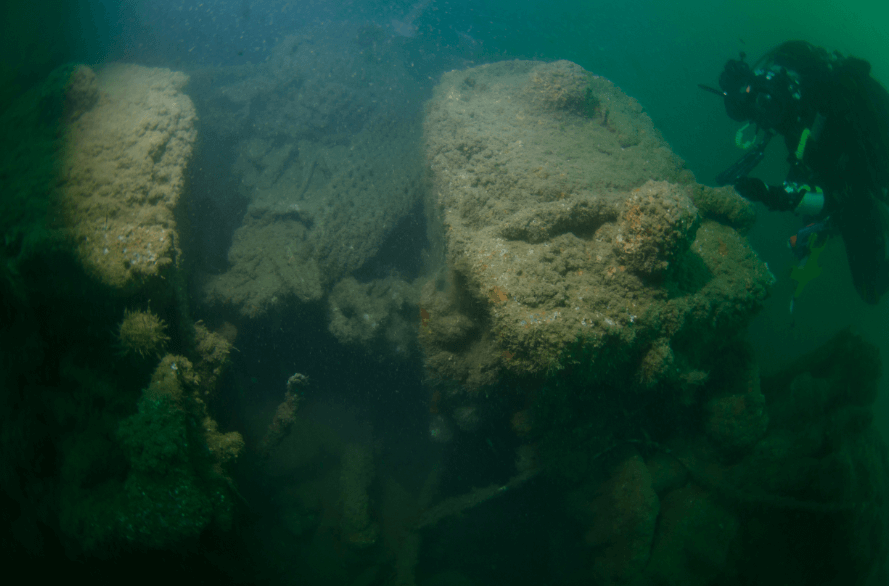
The Wreck
Cylinder heads of the triple expansion engines
Source: MAT
MAT’s archaeology report on HMS Boxer contains these and other images.
